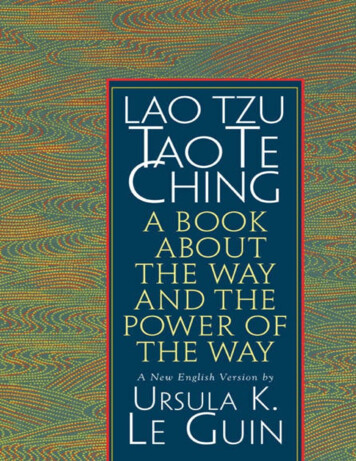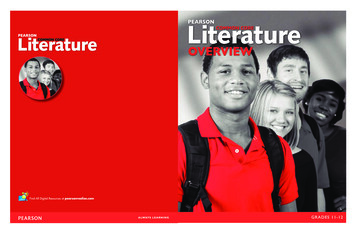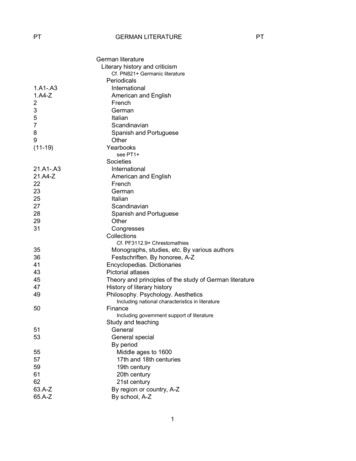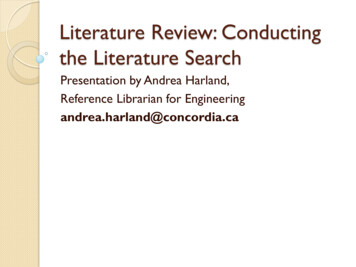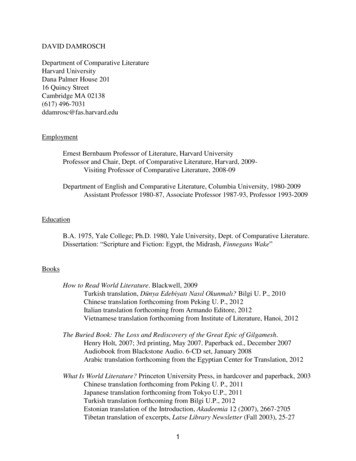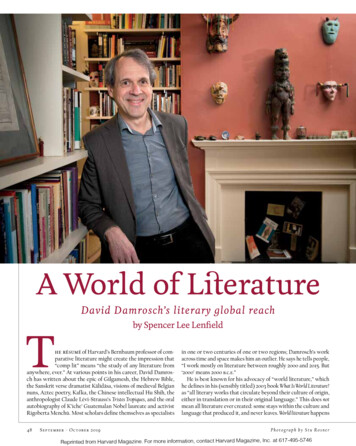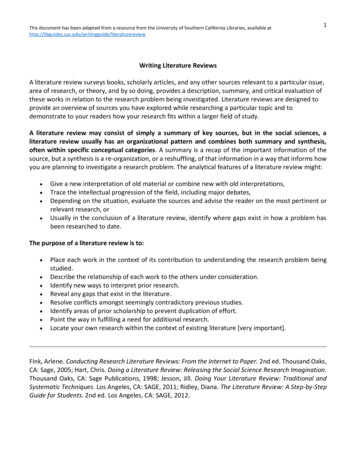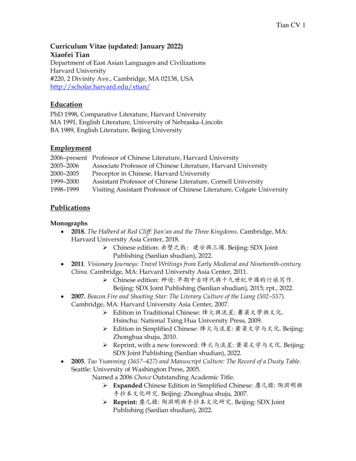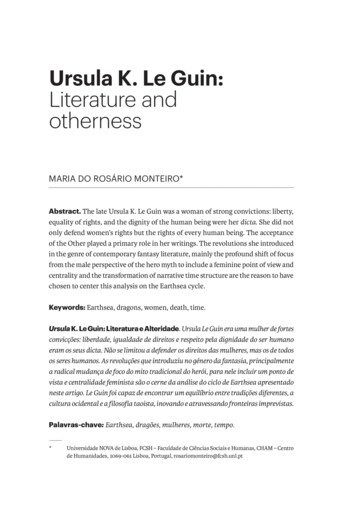
Transcription
Ursula K. Le Guin:Literature andothernessMARIA DO ROSÁRIO MONTEIRO*Abstract. The late Ursula K. Le Guin was a woman of strong convictions: liberty,equality of rights, and the dignity of the human being were her dicta. She did notonly defend women’s rights but the rights of every human being. The acceptanceof the Other played a primary role in her writings. The revolutions she introducedin the genre of contemporary fantasy literature, mainly the profound shift of focusfrom the male perspective of the hero myth to include a feminine point of view andcentrality and the transformation of narrative time structure are the reason to havechosen to center this analysis on the Earthsea cycle.Keywords: Earthsea, dragons, women, death, time.Ursula K. Le Guin: Literatura e Alteridade. Ursula Le Guin era uma mulher de fortesconvicções: liberdade, igualdade de direitos e respeito pela dignidade do ser humanoeram os seus dicta. Não se limitou a defender os direitos das mulheres, mas os de todosos seres humanos. As revoluções que introduziu no género da fantasia, principalmentea radical mudança de foco do mito tradicional do herói, para nele incluir um ponto devista e centralidade feminista são o cerne da análise do ciclo de Earthsea apresentadoneste artigo. Le Guin foi capaz de encontrar um equilíbrio entre tradições diferentes, acultura ocidental e a filosofia taoista, inovando e atravessando fronteiras imprevistas.Palavras-chave: Earthsea, dragões, mulheres, morte, tempo.*Universidade NOVA de Lisboa, FCSH – Faculdade de Ciências Sociais e Humanas, CHAM – Centrode Humanidades, 1069-061 Lisboa, Portugal, rosariomonteiro@fcsh.unl.pt
62Faces de Eva, 40 – EstudosMy goal has always been to subvert as much aspossible without hurting anybody’s feelings.(Le Guin, 1989a)The Earthsea cycle is Le Guin’s major fantasy cycle, a fictional world shestarted developing in 1964 and to which she returned almost until herdeath, in January 2018.(1) Unhurriedly, throughout 53 years, like the Moirae,Ursula Le Guin wove the destiny of humans and dragons, inhabitants of afantasy world made up by a multitude of small microcosms (islands, islets,and rafts). However, the sum of all inhabited regions does not attain thetotality of the fictional world because the West remained uncharted byhumans, a place where some arrive only by flying the “other wind.” AsMoira, Le Guin incorporates the three functions of Klotho, Lakhesis, andAtropos: to spin, to weave and to cut the thread of life, and also the role ofNyx, goddess of the night from whom, according to the Orphic Hymn #3To Nyx,(2) descend both gods and men or, applying the concept to Earthsea,both dragons and humans.Earthsea is a universe in expansion, becoming more multifaceted witheach new story, and changing the original mythical paradigm, adapting itto actual western Weltanschauung.(3) The structure of the first three novelsstands on the hero monomyth, following the crucial stages defined byJoseph Campbell (2004) and Jungian psychology.(4) The readers accompany1.The cycle began with the short-stories “The Word of Unbinding” (1989b) and “The Rule of Names”(1989c), published in Fantastic in 1964, and continued possibly until near her death, since Guin’slast published short story of the cycle, “Firelight”, written in 2017, was published posthumouslyin August 2018 in the Summer Issue of The Paris Review. The novels included in the Earthseacycle are A Wizard of Earthsea (1993b), The Tombs of Atuan (1993c), The Farthest Shore (1993d)Tehanu (1993e) and The Other Wind (2001a) and a collection of short stories, Tales from Earthsea(Le Guin, 2001b). In October 2018 there will be published an illustrated collection containing allthe novels, and most of the short stories – including those published in Tales from Earthsea. Twowill, apparently, be excluded: “Firelight” and “Darkrose and Diamond” (1999). Whenever I referto Earthsea cycle, I am taking in consideration all novels and short stories, written from 1964to 2017. This essay is a full revised version of a paper presented at the International ConferenceLiterary Beasts/Ecrire l’animal, held in the London Metropolitan University, in November 2004.2.“I shall sing of Night, mother of gods and men./(Night – and let us call her Kypris – gave birth/toall.)” (Athanassakis, 1977, p. 7).3.Further, in the essay I will come back to this idea, exploring it more deeply.4.First editions of the initial trilogy: A Wizard of Earthsea in 1968, The Tombs of Atuan in 1971 and TheFarthest Shore in 1972. Campbell and Jung are key theorists in the first novels of Le Guin’s fantasy.
Ursula K. Le Guin: Literature and otherness: 61-75Maria do Rosário MonteiroGed, the black male hero, from birth to early adulthood; follow his descentto the underworld to recover a lost treasure; travel with him again in Ged’sfinal voyage to the world of the dead to restore the pretense equilibrium,returning a drained mage and reborn man.However, between the early 1970s and the early 1990s Le Guin’s mind,as well as that of her first readers, had changed, evolved. The myth of thehero that had been dominant in western culture and suited for young adultmale (Henderson, 1964) needed to be reshaped to continue to make sense tocontemporary readers because, as it stood, it was too simplistic for modernreality and psychological needs.(5) Due to cultural change, says WarrenRochelle, “myths need to be retold, over and over, to be useful. [.] Foreach generation then ‘the myths and tales we learned as children – fables,folktales, legends, hero-stories, god-stories’ must be retold, rethought,revisioned” (2001, p. 33).The tapestry Le Guin weaved in the first three books of the EarthseaCycle no longer echoed the author’s ethos and she “rebelled” against dominant political and cultural western societies’ elites that insisted in perpetuating a social and cultural state of affairs that is no longer actual. In the essay“Unquestioned Assumptions” (2004) Le Guin dismantles five basic westerncultural assumptions that Earthsea cycle takes to pieces. Those assumptionsare: “we’re all men” and “we’re all white” (p. 242), “we’re all straight” and“we’re all Christian” (p. 243), and finally that “we’re all young” (pp. 244-247).At least four of these assumptions are openly dealt with more explicitly inthe two final novels, Tehanu, and The Other Wind, as well as in Tales fromEarthsea. The fictional world complexity grew in the telling, bringing intoHowever, Le Guin always subjected her own work to a constant critical appraisal, recognizing theneed to evolve. Consequently, Campbell and Jung’s works underwent critical reinterpretation andreevaluation, according to Le Guin’s own cultural evolution and constant attention to the world/reality around her. Compare, for instance, the 1974 essay “The Child and the Shadow”, with thefollowing excerpt: “The purposive, utilitarian approach to fantasy, particularly folktale, of a BrunoBettelheim or Robert Bly, and in general the “psychological” approach to fantasy, explaining eachelement of the story in terms of its archetype or unconscious source or educative use, is deeplyregressive; it perceives literature as magic, it is a verbomancy. To such interpreters the spell is aspell only if it works to heal or reveal” (Le Guin, 2007, p. 86).5.As far as I know, Le Guin is the first writer that tries to deal with the need to adapt the hero mythto contemporary western culture. Evolution is a natural process in all myths that “stay alive” ina culture: to continue to make sense, myths evolve along with the changing Weltanschauung inwhich they are active or they “perish”, become void of meaning and stop being used.63
64Faces de Eva, 40 – Estudosthe center elements that stood in the periphery of the first three novels.To trace the profound transformations Le Guin introduced in the fantasycycle, one needs to make a close reading of the texts, comparing the firstthree novels with the texts published after the 90s.Ged’s outstanding achievements narrated in the first novels areunquestioned, his courage remains a fact, and is even exalted by his sternrefusal to occupy the first plan. His tale is sung but does not accuratelyregister history (1993d, pp. 477-478). Tehanu starts, in what concerns theex-mage, where The Farthest Shore ends. Ged is no longer a wizard; just anold man learning how to live as a simple man. As Moss says:A man’s in his skin, see, like a nut in its shell [ ] It’s hard and strong, that shell,and is all full of him. Full of grand man-meat, man-self. And that’s all. That’sall there is. It’s all him and nothing else, inside. [ ] [If he is a wizard then] it’sall his power inside. His power’s himself, see. That how it’s with him. Andthat’s all. When his power goes, he’s gone. Empty. [ ] Nothing. (1993e, p. 528)Ged will have to try to fill the nut again with a different content – thatof ordinary men. Therefore, he will no longer play an essential role in thelater narratives, staying in the background. A source of wisdom, but withoutaction. Moss’s interpretation of Ged’s state is not entirely correct. She too isbiased, her knowledge partial. She cannot understand that the reborn manis not an empty shell but a true Taoist sage who attained the utmost goal ofany Taoist: the wu wei.In Earthsea cycle final fictions, the four loose threads from the initialtrilogy are woven into new ideas: dragons, women, death and time. Theknowledge of their true nature was lost to human memory, buried in thecollective unconscious under layers of history and consciousness laboriously built throughout centuries of conscious human evolution. In the firstthree novels, dragons, women, death and time remained in the peripheryof the plot. They intervene, they act, but mages and society as a whole didnot know them, did not understand their nature: “we’re all men.”Dragons act in A Wizard of Earthsea and The Farthest Shore. However,the human characters in the novels always mediate the image the readerforms of them. Therefore, they are pictured as strange winged beings that,though speaking the Language of Creation, are beyond comprehension:
Ursula K. Le Guin: Literature and otherness: 61-75Maria do Rosário Monteirobeings of power, but treacherous and unpredictable; bringers of destruction for no good rational reason, yet known to be more than just animals.Alternatively, as Ged puts it:The dragons are avaricious, insatiable, treacherous; without pity, withoutremorse. But are they evil? Who am I, to judge the acts of dragons?. Theyare wiser than men are. It is with them as with dreams, Arren. We men dreamdreams, we work magic, we do good, we do evil. The dragons do not dream.They are dreams. They do not work magic: it is their substance, their being.They do not do; they are. (1993d, pp. 334-335)“Dragons have no masters,” therefore a dragonlord is only “one whomthe dragons will speak with” (1993c, p. 248).Furthermore, there is a strong taboo concerning the relationshipbetween men and dragons: no man should ever look into the dragon’s eyesfor he would be destroyed by the primordial knowledge and lose his mind.The eyes are the mirror of the soul. To look into the eyes of a dragon is toenter the realm of primordial knowledge, forbidden to mortal men.Summing up, until the fourth novel, Tehanu, the knowledge humanshave of dragons is based in stories half-remembered, wobbly ideas andtaboos. Besides, this seems to be the main feature of human knowledge inEarthsea and outside fiction: always partial, half-recalled, full of restrictions and preconceptions that have their origin in fear of the unknown andthe eagerness for stability. Dragons, women, death and time are dreadedthemes, misunderstood and better left unquestioned. According to men,no one can understand dragons any better than one understands women(and their magic), or death, or time.The myth of creation, retold annually throughout Earthsea, cannotwholly perform its function of uniting people and giving sense to theirlives, bonding the communities. It shares the same features of all knowledgetaught in the dominant male culture of the archipelago, that of the InnerLands: it is only partially retold, adapted to men’s social and cultural conditions. However, in the process of adaptation, men forgot part of the storyand retained just what still made sense to their conscious mind: Segoy, theEldest, created the world out of the water by naming every bit of matter; thenhe created dragons. There is no explicit connection made in The Creation65
66Faces de Eva, 40 – Estudosof Éa, as it is remembered and sang, between dragons and humans, thoughsome reminiscence of ancient knowledge persists in the common idea thatdragons are older than humankind, share the same creator, Segoy, and thereare strange stories alluded to, but protected by some kind of secrecy.(6)As to the peripheral position of women in Earthsea, much of whatwas said about dragons also applies to them. A role is allotted to Women,who are respected as long as they comply with the following eight tasks:“bed, breed, bake, cook, clean, spin, sew, serve” (1993e, p. 509). If they cando these correctly, they deserve respect. However, if they have the power ofmagic, or if they act outside their restricted assigned role, they are feared,rejected outcasts.There is a clear relationship between women, the Old Powers of Earth,and the chaotic matter Segoy ordered. Both share a common origin withmages’ magic, but while magic is studied, revered, and stands as the central pillar of society and its culture, the Old Powers are dangerous forces,uncontrollable, unpredictable, like dragons, women or time. Women ofpower, that is, women who do not live solely by the eight tasks mentionedabove, or that in some way are perceived as being odd or different accordingto the standards of normality, constitute a threat.Tenar, in Atuan, is a dangerous woman because she is the reincarnatedpriestess of the Old Powers. In the Inner Lands, the fact that she broughtthe Ring of Erreth-Akbe, with the Rune of Peace, is not a token that canguarantee her the respect of ordinary people. Her skin is of a different color,she speaks an odd language, she mingled with mages, and was a priestess –therefore she is strange and is sent to the periphery of society.In The Farthest Shore, Tenar is mentioned only three times, as someonewho took part in essential past adventures.(7)Moving now to the third peripheral theme, death, it remains on thethreshold of the first two novels. Ged goes to the world of the dead following a child and summons the shadow that will pursue him throughout AWizard of Earthsea, but the theme is not developed. In The Tombs of Atuan,Tenar serves the Old Powers, but these have to do with life and death, theyare a manifestation of the powers of the Great Mother and should not be6.Namely, the stories collected in Tales from Earthsea.7.She is mentioned in passing in the first chapter of The Farthest Shore (p. 309) and then two moretimes by Ged in p. 441.
Ursula K. Le Guin: Literature and otherness: 61-75Maria do Rosário Monteirointerpreted as having only a negative meaning. In the whole cycle, Ged is oneof the few characters who acknowledges the ambivalence of these Powers.In what concerns the third novel, though death is one of the majorthemes, it is not its central issue: Ged and Lebannen’s quest is to stop a magewho is meddling with death to gain power over the living. It is with the lifeand the harmony in Earthsea, in the world, that they are concerned. If theydo not stop Cob, the future King will not have a kingdom at all. The FarthestShore is, at the same time, a Bildungsroman in the sense that one of Ged’sfunctions is to shape the character of the future kind, teach him that deathis a natural consequence of living.Nevertheless, death seemed a senseless waste. The dead inhabited aworld built exactly like the real, living world, but without any use, or purpose. The dead wandered about with nothing to see, do, or feel. Mothersignored their children, lovers forgot their loved ones, and heroes roamedthe dusty land senselessly. Death was only the doorway to limbo.This vision of death and its domain is in contradiction with the Taoistphilosophy, and this contradiction underlies the whole cycle. However, thisdescription of death did not make sense, considering Taoist philosophy isa structural feature of this fictional world. Built upon the idea of balancebetween yin and yang, death had to be more than what was described or,at least, different.According to Taoist philosophy, death is as natural as life itself, part ofNature and the way it evolves, part of the Tao: “where there’s birth, there’sdeath; where there’s death, birth. Where there’s a possible, there is theimpossible, – with the impossible, the possible is” (Chuang-Tzu, 1998, p. 11).The underworld cannot be just what is portrayed in the first three novels ofthe cycle: a dreadful world, dominated by pain, psychological punishment,and total indifference. In Taoism, life and death are connected with time–not the linear time of western culture, but with time evolving perpetually,with change, with the cycle of Nature, evolving from equilibrium to imbalance to achieve a new (different) equilibrium.The wind and the seas, the powers of water and earth and light, all that thesedo, and all that beasts do and green things do, is well done, and rightly done.All these act within the Equilibrium. From the hurricane and the great whale’s67
68Faces de Eva, 40 – Estudossounding to the fall of a dry leaf and the gnat’s flight, all they do is done withinthe balance of the whole. (1993d, p. 361)The equilibrium of Earthsea cannot be attained if the four peripheralissues are not brought to the center of the plot, and dealt with thoroughly.Society cannot be in equilibrium if the relationship between men andwomen is not balanced. If they do not understand where they stand in thegrand scheme of creation, intelligent species cannot live harmoniously inthe world. If death is meaningless, Life cannot be fully experienced. If timeis not understood as the essence of evolution, human societies will notevolve and will perish, menacing the whole Equilibrium.After Ged’s final quest, Earthsea continued without experiencingthe full benefits of having a King in the throne, of having a proper center,because much else was still unbalanced in the minds of every inhabitantof the Inner Lands, as well as in the social, political and cultural structures.The end of The Farthest Shore could not be a conclusion to Earthsea.If it were, Ged’s life would have been one painful experience of humility. Agreat mage, probably greater than the venerated Erreth-Akbe, but the wholeworld would remain unbalanced. As long as men were the center, action themotto, time linear and women peripheral, Earthsea would keep botheringUrsula Le Guin’s philosophy and her acute sense of creative responsibility,issues she addresses in Earthsea revisioned (1993a).From 1972 on I knew there should be a fourth book of Earthsea, but it wassixteen years before I could write it. [ ] but now, instead of using the pseudogenderless male viewpoint of the heroic tradition, the world is seen through awoman’s eyes. This time the gendering of the point of view is neither hiddennor denied. [ ] In my lifetime as a writer, I have lived through a revolution,a great and ongoing revolution. When the world turns over, you can’t go onthinking upside down. What was innocence is now irresponsibility. Visionsmust be revisioned. (1993a, pp. 11-12)Tehanu is the novel where taboos regarding women, dragons and timestart being dismantled. With them, inevitably, the question of male power isalso challenged. Tenar, despite her inability for magic, is a woman of powerfor she can question prejudices, she seeks the hidden meaning under the
Ursula K. Le Guin: Literature and otherness: 61-75Maria do Rosário Monteirocloak of the convention, and she challenges the pride and arrogance ofpower and ignorance. She experienced different ways of living as a womanin Earthsea: she was a priestess, a companion to and apprentice of mages,a wife, a mother, and a farm-keeper. At the beginning of Tehanu, she is awidow raising an abused and crippled orphan child. Long before, she hadchosen to leave Ogion’s kind protection to experience the standard roleof women in Earthsea: “bed, breed, bake, cook, clean, spin, sew, serve.”However, she is also a woman of knowledge that does not forget easily.Her quest is to find what a woman’s power is, or stating it differently: whatpower is. Although she does not fully realize the extension of her knowledge, acquired in different parts of the archipelago and through a varietyof experiences, the reader, through her recollections, can view the wholescheme of creation and start filling the gaps of the incomplete informationprovided in the first three novels. The power of a woman lies in her abilityto be different things through time, and the roots of that power are deeplyplunged at the beginning of creation. Mossy formulates Tenar’s quest in anuneducated and biased statement:Oh, well, dearie, a woman’s a different thing entirely. Who knows where awoman begins and ends? Listen, mistress, I have roots, I have roots deeperthan this island. Deeper than the sea, older than the raising of the lands.I go back into the dark. [.] I go back into the dark! Before the moon I was.No one knows, no one knows, no one can say what I am, what a womanis, a woman of power, a woman’s power, deeper than the roots of trees,deeper than the roots of islands, older than the Making, older than themoon. Who dares ask questions of the dark? Who’ll ask the dark its name?”(1993e, pp. 528-529)Nonetheless, Tenar knows best: she can and will question the dark itsname. It is through Tenar that the lost knowledge of the dragons is recoveredand brought back to the first plan. Remembering a tale the old mage Ogionhad told her, she teaches her adopted child not only the traditional Creationof Éa but also the lost knowledge kept by a dragon-woman: the story of theWoman of Kemay which states definitely that, “in the beginning, dragonand human were all one. They were all one people, one race, winged, and69
70Faces de Eva, 40 – Estudosspeaking the True Language”(8) (1993e, p. 492). It is here that the dark hasits name: in the creation of nature and in its evolution in time.These first dragons are a symbol of the primordial unity, before any differentiation. Len Hatfield says that for these dragons there is no dichotomybetween mind and body, subject and object (1993, p. 58). The first dragonscreated by Segoy are the expression of the primordial unity. However, sinceEarthsea was initially structured as a universe in balance between twoopposites, the one had to give place to the two. All creation exists in timeand, as Tenar says, “in time nothing can be without becoming” (1993e, p.492). It is the fundamental Taoist principle that unites everything in Nature.Not western male linear time, not the circular time of the male hero tale,but the feminine time, the time of endless evolution and transformationthrough the acceptance of the Other and having its roots in the past. Burchillformulated this idea when she states:becoming-woman as a mode of repetition constitutive of the future is distinguished from the repetition or reproduction of feminine gender traits in that,instead of contenting itself with including difference as a variant within (anenlarged field of) the Same, it extracts from the sedimentation of the past,elements ‘pertaining to difference’, which it then enfolds – or reiterates – innew configurations that no longer take their bearing from the past as it iscongealed, nor from the present as the deployment of variations informedby this past. (2010, p. 94)(9)Asking the dark its name, Tenar discovers Dragons became two different races with altered interests and ways of life. With the differentiationcame hate and distrust that lead to conflict, and further differentiation.Kalessin/Segoy confirms what, somehow, Tenar already knows from oldtales:8.The story is told in Tehanu, pp. 490-493.9.Based on Burchill assertions, Donaldson studies Le Guin’s fantasy cycle from a postmodernistfeminist theory and comes to a similar conclusion regarding the feminine and her connection withtime as becoming stating “‘becoming’ is about infinite possibilities and not the achievement ofa unified ‘identity’ and it therefore enables the destabilisation of categories that have inhabitedsomewhat static and stable positions in the symbolic order, such as the term ‘woman.’”(2013, p. 41).
Ursula K. Le Guin: Literature and otherness: 61-75Maria do Rosário MonteiroOnce we were one people. And in sign of that, in every generation of men, oneor two are born who are dragons also. And in every generation of our people,longer than the quick lives of men, one of us is born who is also human. Ofthese one is now living in the Inner Isles. And there is one of them living therenow who is a dragon. These two are the messengers, the bringers of choice.There will be no more such born to us or to them. For the balance changes.(2001a, p. 152)The unique beings that are born in every generation of men and dragonform two additional entities that are not quite human nor dragon; thirdand fourth alternatives that help balance the race. The two specific beingsmentioned by Kalessin as living in the Inner lands are Tenar and Tehanu.Tehanu is one of the dragons born to humans, as was the Woman of Kemay.Tenar is one of the humans born to dragons. She was the priestess of the OldPower, the one that is perpetually reborn: “All human beings were foreverreborn, but only she, Arha, was reborn forever as herself” (1993c, p. 214).Tenar’s nature allows her to ask the dark its name. That is also whyshe can look Kalessin in the eye and talk to the Creator. Being human shecannot fly, being dragon she is free, untamable, more substantial than therole allotted to her as a woman. Tenar and Tehanu are the results of theconjunction oppositorum, two different balanced beings sharing two natures,and they will be responsible for the final dismantling of the assumptionsreferred to by Le Guin: we’re not all men, we’re not all white, we’re not allstraight, we’re not all Christian, and we’re all young.Tenar’s ability to remember the past is directed to the nature of humanand dragons. She never forgot the images drawn on the walls of the PaintedRoom, and it is to her that the weaver of Re Albi reveals the pictures ofdragons with human eyes weaved on the backside of the fan (1993e, pp.576-577). The essential difference between these two paintings lies in theeyes of the figures: in the fan, the dragons have lively human eyes, and inthe Painted Room, the winged figures have sad blind eyes. Tenar feels thatthose gloomy eyes have to do with the inability to die experienced by theinhabitants of the Inner Land, a task that will be carried out with the helpof Tehanu-Dragon.The changes in Earthsea will be profound and with unpredictableoutcomes. The unbalance felt was the consequence of mistakes made71
72Faces de Eva, 40 – Estudosthroughout centuries by people acting out of ignorance or pride. The caution taught by the wizards of Roke is, most of the times, a mere rhetoricalstance because the knowledge they possess is partial and biased. Theirs isthe one-sided knowledge of consciousness. Furthermore, their prejudicetowards different kinds of magic, like the one performed by women, prevented them from attaining a wholly balanced picture of the outcome ofany action. The prophecy regarding the new king was fulfilled, and changesbegan to be felt on the political level. However, for these changes to be effective, another must occur. Magic must find its new reformer because the oldset of Rules no longer functions and Roke does not have a leader. A womanon Gont must also fulfil the prophecy of Master Patterner.In The Other Wind the structure of the novel does not have one leading character, as in the previous narratives, but a set of characters, eachresponsible for part of the action. The transformation of Earthsea no longerdepends on the heroic acts of one male character. The shared responsibilityis one more change that Le Guin introduces in the traditional monomyth.Eight characters, four male, and four female, play each their part: Tenar,Tehanu, Irian, and Seserakh lead the group having the task of questioningold biased truths and bringing forth the knowledge hidden in the collective unconscious; Lebannen is the king who assumes his responsibility toprotect the people and assure that what has to be done will be done. He alsohas to set an example of a balanced relationship between men and women,based on respect and the acceptance of differences. Adler is the one calledforth by chance to act when fear and prejudice paralyze the educated ones.Master Patterner is the link that binds the prophecy and the future, a trueTaoist, while Master Summoner has the task of redeeming past actions.The final equation – dragon, women, death and time – is solved. Leadby women, people begin to look for what has been forgotten, reconstructingthe puzzle of memory. The real kinship of dragons and humans is confirmed,as is the conflict that led them apart.The meaninglessness experienced in the land of the dead was, in fact,a hard punishment: the complete lack of sense that drained beauty out oflife. Everything that humans achieved in life, through hard work and action,lost its meaning in the utter eternal apathy.Tehanu and Adler are the ones to start dismantling the wall circumscribing the world of the dead, allowing them to dissolve freely into Nature.
Ursula K. Le Guin: Literature and otherness: 61-75Maria do Rosário MonteiroHuman origins are acknowledged, women have their rights re-evaluated in a more balanced relationship with men and society. Their powerthat once stood in the foundations of magic, and
Ursula Le Guin wove the destiny of humans and dragons, inhabitants of a fantasy world made up by a multitude of small microcosms (islands, islets, . and a collection of short stories, Tales from Earthsea (Le Guin, 2001b). In October 2018 there will be published an illustrated collection containing all the novels, and most of the short stories .
